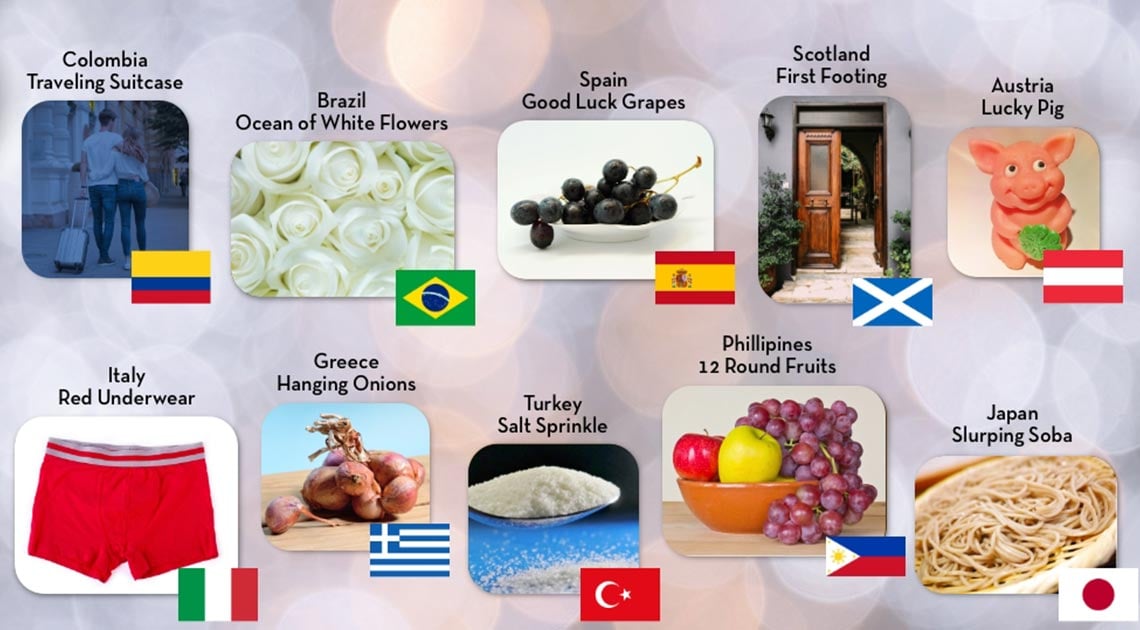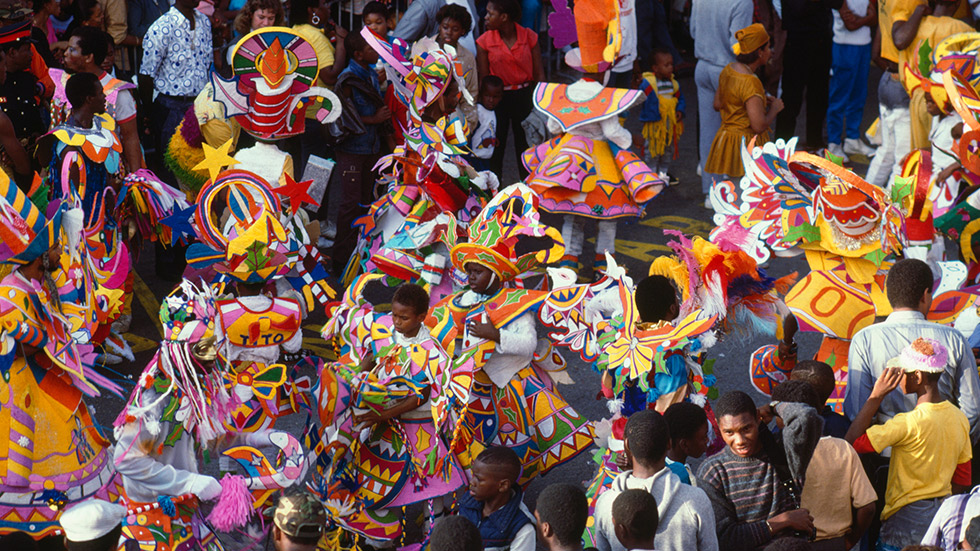Explore New Year Traditions Around the World
Pick your family's favorite traditions to ring in the new year


The New Year is almost here!
There are New Year’s traditions and customs around the world, each aiming at the same goal of welcoming a healthy, lucky New Year. Here are some traditions – some simple, some elaborate – you can try with your family to boost your chances of having the best year ever.
SPAIN - GOOD LUCK GRAPES
In Spain, New Year's Eve, or Nochevieja, is celebrated with a tradition called las doce uvas de la suerte (the twelve grapes of luck). At midnight, Spaniards eat twelve grapes, one for each clock's chime, to bring good luck for each month of the new year.
Feliz Año Nuevo! (Feh-LEEZ AH-nyo NWEH-vo)
SCOTLAND - FIRST-FOOTING
Scotland's New Year's Eve celebration, Hogmanay, includes the tradition of "first-footing." According to the custom, the first person who crosses the threshold of a person's home in the new year should bring a gift of luck. Traditionally, this gift was coal for the fire or shortbread. The New Year’s song Auld Lang Syne was originally from a Scottish poem.
COLUMBIA - TRAVELING SUITCASE
This is one of our favorites! Colombians walk around the block with an empty suitcase as the clock strikes midnight to ensure the new year is full of travel and adventure.
Also, when midnight strikes, Colombians take their first step of the year with their right foot to ensure the year starts on the right foot.
Feliz Año Nuevo! (Feh-LEEZ AH-nyo NWEH-vo)
AUSTRIA - LUCKY PIGS
In Austria, pigs are a symbol of good luck. People often give gifts of marzipan or chocolate pigs.
Frohes Neues Jahr! (FROH-es NOY-es YAR)

ITALY- RED UNDERWEAR
Italians have the tradition of wearing red underwear on New Year's Eve to bring love and luck in the new year. In medieval times, red was believed to ward off witches and evil spirits.
Buon anno! (BWO-nan-NO!)
TURKEY - SALT SPRINKLE
In Turkey, sprinkling salt on your doorstep is considered good luck as soon as midnight strikes. It's said to promote peace and prosperity throughout the new year.
Mutlu yıllar! (Moot-loo YUH-lahr)
PHILIPPINES - 12 ROUND FRUITS
It's popular in Filipino culture to celebrate the new year by serving 12 round fruits, like apples, melons, oranges, and grapes. The round shape symbolizes coins, representing prosperity and wealth for each month of the coming year. Many families display the fruit on their dining table; some eat 12 round fruits at midnight.
Manigong Bagong Taon! (Ma-nee-GONG Ba-gong Ta-ON)
JAPAN - SLURPING SOBA
The Japanese eat soba noodles just before midnight on New Year's Eve. The long soba noodles symbolize crossing from one year to the next. And as it's an easily cut noodle, it signifies letting go of the past year before starting fresh in the new year.
Watching the first sunrise of the year, known as hatsu-hinode (first sunrise), is considered auspicious in Japan. Many people climb hills or visit coastal areas to witness it.
Akemashite omedetō gozaimasu! (ah-keh-mah-SHI-teh oh-MEH-deh-TOH goh-zah-ee-MAHS)

BRAZIL - OCEAN OF WHITE FLOWER
The New Year's Eve tradition in Brazil is called Réveillon. Many Brazilians wear white to symbolize prosperity and gather on the beach to offer white flowers and candles to Iemanjá, the Goddess of the Sea. If the offering floats out to sea, she has accepted it, and you will have a good year.
Feliz Año Novo! (Feh-LEEZ Ah-noh NOH-voh)
GREECE - HANGING POMEGRANATE & ONION
In Greece, for New Year's, people have a tradition of hanging a pomegranate on their front door starting at Christmas, leaving it up until the New Year. Then, a family member smashes the pomegranate at the front door to bring good luck and happiness to their home. The more scattered seeds, the better the luck is believed to be. Some do this at midnight on New Year's Eve, and others in the new year after church. (Kids should check with their parents before exploding a pomegranate on your floors). Another ritual involves hanging an onion at the doorstep, which is believed to chase away evil.
Kali protohronia! (KAH-lee pro-toh-HRO-nee-ah)
CHINA - PAPER LANTERNS
In China, paper lanterns are lit and released into the sky on New Year's Eve as a symbol of letting go of the old and embracing the new.
Xīn nián kuài lè! (SHEEN knee-ANN kwai LER)
DENMARK - SMASHING PLATES
A tradition in Denmark known as Kattehale involves Danes throwing and breaking old plates and glasses against the doors of friends and family. It’s a way to show you love them. The more tableware you throw, the more you care. The smashing noise is believed to ward off evil spirits, allowing for a prosperous new year.
Some Danish people jump off a chair or sofa and “into the new year.”
Godt nytår! (Goth NYT-or!)

BAHAMAS - JUNKANOO
Junkanoo is a lively and colorful Bahamian parade featuring vibrant costumes, music, and dancing, held on New Year's Day and Boxing Day (December 26th).
U.S. – GOOD LUCK PEAS & GREENS
In the Southern United States, people eat black-eyed peas and greens for good luck and prosperity in the new year. The peas, with their coin-like shape, symbolize wealth, and the greens represent money.
FIRST KISS
Did you know the midnight kiss tradition dates back to English and German folklore? The kiss will set the tone for your relationship in the coming year.
Each culture has its unique way of ringing in the new year with hope, luck, and positive energy.
Happy New Year to you and your family! Adventure Awaits!
